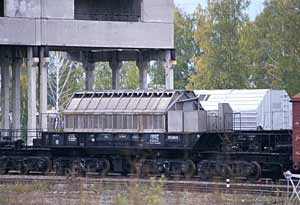
New Managing Director for Bellona Norway
The Board of the Bellona Foundation has appointed former Minister of Climate and the Environment Sveinung Rotevatn as Managing Director of Bellona No...
News

Publish date: April 3, 2000
Written by: Igor Kudrik
News
A nuclear train carrying a load of spent nuclear fuel from a Ukrainian nuclear power plant arrived to Zheleznogorsk, Krasnoyarsk County. The fuel derives from Zaporozhye NPP, which licensed a dry storage site for spent nuclear fuel in attempt to quit costly shipments to Russia.
Ukrainian nuclear power plants, which operate VVER-1000 reactors, have been shipping their spent fuel for storage at Krasnoyarsk Mining and Chemical Combine in Zheleznogorsk (former Krasnoyarsk-26) since 80-s. After the split up of the Soviet Union, Ukraine had to pay for this service. And although the price is far below of the international going rate, the shipment is deemed to be a burden to the shrinking economy of the former Soviet republic.
Ukraine operates five nuclear power plants with 14 reactor units, including 11 VVER-1000 type reactors.
Rate increase and dry storage
In early December 1998, Krasnoyarsk County governor, Aleksandr Lebed, said the mining and chemical combine in his county would not accept spent nuclear fuel from Ukraine for “small money”. The deadlock over the price ended up by $45 rate increase, making the price tag $330 per kilogram in 1999.
A Ukrainian VVER-1000 reactor has 50-55 fuel assemblies replaced each year – one third of a VVER-1000 reactor core. Annual shipments of spent nuclear fuel to Russia cost Ukraine around $100-120 million a year.
Last year, Ukrainian Zaporozhye NPP had reportedly licensed a storage pad for containers with spent nuclear fuel. The storage technology was transferred to Ukraine by American Duke Engineering & Services that was contracted by the U.S. Department of Energy. Zaporozhye NPP has paid for manufacturing of two containers for test operation. Plant’s officials say 380 more containers will be needed to store the spent nuclear fuel from the plant during 50 years to come.
The containers are made of concrete, have three meters in diameter and contain helium to cool down the spent fuel. Each container can hold 24 fuel assemblies. Ukrainian Energy Ministry, Energoatom, believes that should this scheme function well at Zaporozhye NPP, other nuclear plants can start using it as well.
Minatom gets nervous
Officials of the Russian Ministry for Nuclear Energy, or Minatom, watching Ukraine’s attempts to abandon fuel shipments to Russia, said the Ukraine would face the same problem with spent nuclear fuel as it has today after 50-year operation period for the containers ends. According to Vladimir Shidlovsky, head of the Minatom’s Fuel Cycle Department, Ukraine has very favourable fuel shipment agreement with Russia, which stipulates prices three folds below the international rates. More than 50 per cent are paid through barter agreements, rather than cash.
On the other hand, what makes Minatom to accept so unfavourable agreements for itself and put efforts to convince Ukraine to follow the shipment scheme?
Krasnoyarsk Mining and Chemical Combine (KMCC), where the fuel is shipped, includes an underground radiochemical plant with military three reactors; two are now closed and the third produces heat and electricity for the city. The plant was commissioned in 1964 to reprocess spent fuel from its own reactors to extract weapon grade plutonium.
But the nuclear weapon material production relates to the past of the combine. The present and the future of KMCC depend on the RT-2 reprocessing plant now 30 per cent complete. The construction of the reprocessing plant was put on hold in 1989. The new Minatom’s strategy outlined recently suggests completing it not earlier than in 2015. The first stage of the plant – wet storage for VVER-1000 spent fuel with a capacity of 6,000 tons – was, however, commissioned in 1985. The storage is now around 40 per cent full. By 2005-2007, the capacity of the storage will be used up for 100 per cent. Today, Minatom suggests building an additional dry storage at KMCC. The project is said to have been under development since 1998. The construction is to be launched in 2001 and with the storage site commissioned in 2005. The new dry storage is designed to hold 33,000 tons of spent fuel, including 24,000 tons of RBMK-type reactor fuel and 9,000 of VVER-1000-type reactor fuel.
The funding sources, given no foreign spent fuel imports are allowed, come primarily from Rosenergoatom, the Russian state operator of nuclear power plants, Russian nuclear power plants and Ukrainian nuclear power plants. In terms of the VVER-1000 reactors, Ukraine must be, according to Minatom, the major contributor since it operates 11 units and plans to complete two more units in the near future. Russia operates seven VVER-1000 units.
Thus, the steps undertaken by Ukraine to break the nuclear dependency links with Russia are taken with nervousness at Minatom. Ukraine is, after all, the only real partner in Minatom-laid plans in comparison to the virtual prospects drawn on paper by this agency so far.

The Board of the Bellona Foundation has appointed former Minister of Climate and the Environment Sveinung Rotevatn as Managing Director of Bellona No...

Økokrim, Norway’s authority for investigating and prosecuting economic and environmental crime, has imposed a record fine on Equinor following a comp...

Our op-ed originally appeared in The Moscow Times. For more than three decades, Russia has been burdened with the remains of the Soviet ...

The United Nation’s COP30 global climate negotiations in Belém, Brazil ended this weekend with a watered-down resolution that failed to halt deforest...